Islamic flags
An Islamic flag is a flag either representing an Islamic denomination or religious order, state, civil society, military force or other entity associated with Islam. Islamic flags have a distinct history due to the Islamic prescription on aniconism, making particular colours, inscriptions or symbols such as crescent-and-star popular choices. Since the time of the Islamic prophet Muhammad, flags with certain colours were associated with Islam according to the traditions. Since then, historical Caliphates, modern nation states, certain denominations as well as religious movements have adopted flags to symbolize their Islamic identity.
History
Early Islam
Before the advent of Islam, banners as tools for signaling had already been employed by the pre-Islamic Arab tribes and the Byzantines. Early Muslim army naturally deployed banners for the same purpose.[1] Early Islamic flag, however, greatly simplified its design by using plain color, due to the Islamic prescriptions on aniconism.[2] According to the Islamic traditions, the Quraysh had a black liwāʾ and a white-and-black rāya.[3] It further states that Muhammad had an ʿalam in white nicknamed "the Young Eagle" (Arabic: العقاب al-ʿuqāb); and a rāya in black, said to be made from his wife Aisha's head-cloth.[4] This larger flag was known as " the Banner of the Eagle" (Arabic: الراية العقاب al-rāyat al-ʻuqāb), as well as "the Black Banner" (Arabic: الراية السوداء ar-rāyat as-sawdāʾ).[5] Other examples are the prominent Arab military commander 'Amr ibn al-'As using red banner,[6] and the Khawarij rebels using red banner as well.[7] Banners of the early Muslim army in general, however, employed a variety of colors, both singly and in combination.[8]
During the Abbasid Revolution, the Abbasids incorporated the Black Standard based on the early-Islamic eschatological saying that "a people coming from the East with black banners" would herald the arrival of the messianic figure Mahdi.[9] The Umayyad opponents, as well as the Shiite Alids chose the color of white to distinguish themselves from the Abbasids.[7] Abbasids continued to deploy black as their dynastic color. However, their caliphal banner was made of white silk with the Quranic inscriptions. The white color was continually adopted by the Ismaili-Shiite Fatimid Caliphate, and cemented the association of black and white with Sunni and Shia respectively. Fatimid caliphal banner was decorated in red and yellow, sometimes emblazoned with a picture of a lion.[10]
Middle Ages
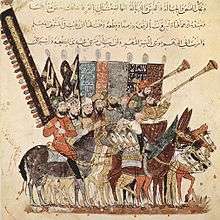
The Ayyubids and Mamluks, succeeding the Fatimid caliphate, retained the association with yellow. The Ayyubid founder Saladin carried a yellow flag adorned with an eagle. Mamluk sultanic banners were yellow, but on occasion they used red banners.[10] Mongol and Turkic dynasties to the east, including the Ilkhanate, Oghuz Turks and the Seljuq dynasty, preferred the white banner.[11] Religious flags with inscriptions were in use in the medieval period, as shown in miniatures by 13th-century illustrator Yahya ibn Mahmud al-Wasiti. 14th-century illustrations of the History of the Tatars by Hayton of Corycus (1243) shows both Mongols and Seljuqs using a variety of war ensigns.
The crescent appears in flags attributed to Tunis from as early as the 14th century Book of Knowledge of All Kingdoms, long before Tunis fell under Ottoman rule in 1574. The Spanish Navy Museum in Madrid shows two Ottoman naval flags dated 1613; both are swallow-tailed, one green with a white crescent near the hoist, the other white with two red stripes near the edges of the flag and a red crescent near the hoist.[12]
The hexagram was also a popular symbol among the Islamic flags. It is known in Arabic as Khātem Sulaymān (Seal of Solomon; خاتم سليمان) or Najmat Dāwūd (Star of David; نجمة داوود). The "Seal of Solomon" may also be represented by a five-pointed star or pentagram. In the Qur'an, it is written that David and King Solomon (Arabic, Suliman or Sulayman) were prophets and kings, and are figures revered by Muslims. The Medieval pre-Ottoman Hanafi Anatolian beyliks of the Karamanids and Jandarids used the star on their flag.[13]
The Mamluks served the Custodian of the Two Holy Mosques during their reign. During this time, they deployed what was believed to be the genuine relic of the Islamic prophet Muhammad's banner. The banner was later captured by the Ottomans, who called the flag "noble banner" (sancak-i s¸erif) and used it during their military campaign. The flag was made of black wool, according to the Ottoman historian Silahdar Mehmed Agha, but there is no further information available.[14]
 The Ayyubid yellow standard
The Ayyubid yellow standard The flag of the Mamluk sultanate
The flag of the Mamluk sultanate The flag of the Kingdom of Tlemcen[15]
The flag of the Kingdom of Tlemcen[15] The Karamanid dynastic flag
The Karamanid dynastic flag
Pre-modern era
- Ottoman Empire
War flags came into use by the Ottoman Empire in the 16th century, gradually replacing (but long coexisting with) their traditional tugh or horse-tail standards. During the 16th and 17th centuries, war flags often depicted the bifurcated sword of Ali, Zulfiqar, which was often misinterpreted in Western literature as showing a pair of scissors.[16] A Zulfiqar flag used by Selim I (d. 1520) is on exhibit in Topkapı Palace.[17] Two Zulfiqar flags are also depicted in a plate dedicated to Turkish flags in vol. 7 of Bernard Picart's Cérémonies et coutumes religieuses de tous les peuples du monde (1737), attributed to the Janissaries and Sipahis.
Tanzimat of 1844, the flags of the Ottoman Empire were redesigned in the style of European armies of the day. The flag of the Ottoman Navy was made red as red was to be the flag of secular institutions and green of religious ones. As the reforms abolished all the various sub-sultanates, pashaliks, beyliks and emirates, a single new flag was designed to replace all the various flags used by these entities with one single national flag. The result was the red and white flag with the crescent moon and star, which is the precursor to the modern Turkish flag. A plain red flag was introduced as the civil ensign for all Ottoman subjects.
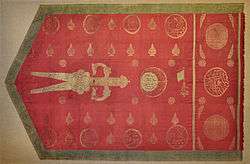 An early 19th-century example of a Zulfiqar flag
An early 19th-century example of a Zulfiqar flag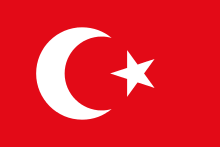 The flag of the Ottoman Empire (1844-1923)
The flag of the Ottoman Empire (1844-1923)
- Mughal Empire
The Mughal Empire had a number of imperial flags and standards. The principal imperial standard of the Mughals was known as the alam (Alam علم). It was primarily moss green.[18] It displayed a lion and sun (Shir-u-khurshid شیر و خورشید) facing the hoist of the flag.[19] The Mughals traced their use of the alam back to Timur.[20] The imperial standard was displayed to the right of the throne and also at the entrance of the Emperor's encampment and in front of the emperor during military marches.[20]
According to the Ain-i-Akbari, during Akbar's reign, whenever the emperor rode out, not less than five alams were carried along with the qur (a collection of flags and other insignia) wrapped up in scarlet cloth bags. They were unfurled on the days of festivity, and in battle.[21] Edward Terry, chaplain to Sir Thomas Roe, who came during the reign of Jahangir, described in his Voyage to East-India (1655) that the royal standard, made of silk, with a crouching lion shadowing part of the body of the sun inscribed on it, was carried on an elephant whenever the emperor travelled.[22][23]
 Possibly the initial flag of the Mughal Empire
Possibly the initial flag of the Mughal Empire Alam of the Mughal Empire
Alam of the Mughal Empire.png) Flag of the Mughal Empire (1857)
Flag of the Mughal Empire (1857)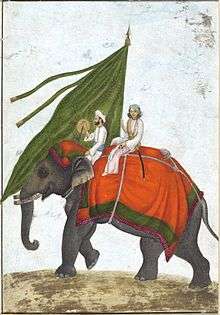 An elephant with a mahout and a standard-bearer carrying a green standard with a gold sun.
An elephant with a mahout and a standard-bearer carrying a green standard with a gold sun.
- Persian Empires
The Safavid Dynasty (1501–1736) employed various alams and banners, especially during the reign of the first two kings, each with a different emblem. Ismail I, the first Safavid king, designed a green flag with a golden full moon. In 1524 Tahmasp I replaced the moon with an emblem of a sheep and sun; this flag was used until 1576. It was then that Ismail II adopted the first Lion and Sun device, embroidered in gold, which was to remain in use until the end of the Safavid era. During this period the Lion and Sun stood for two pillars of the society: the state and Islam.
The Afsharid dynasty (1736–1796) had two royal standards, one with red, white, and blue stripes and one with red, blue, white, and yellow stripes. Nader Shah's personal flag was a yellow pennant with a red border and a lion and sun emblem in the centre. All three of these flags were triangular in shape.[24][25] Nader Shah consciously avoided the using the colour green, as green was associated with Shia Islam and the Safavid dynasty.[26]
 Flag of Safavid Dynasty after Ismail II (1576–1732)
Flag of Safavid Dynasty after Ismail II (1576–1732).svg.png) An Imperial Standard of the Afsharid dynasty
An Imperial Standard of the Afsharid dynasty
Modern history
- Star and crescent
By the mid 20th century, the star and crescent was used by a number successor states of the Ottoman Empire, including Algeria, Azerbaijan, Mauritania, Tunisia, Turkey, the Turkish Republic of Northern Cyprus and Libya. Because of its supposed "Turkic" associations, the symbol also came to be used in Central Asia, as in the flags of Turkmenistan and Uzbekistan. The star-and-crescent in the Flag of Pakistan is stated as symbolizing "progress and light" (while the green colour is stated as representing Islam). The star-and-crescent in these flags was not originally intended as religious symbolism, but an association of the symbol with Islam seems to have developed beginning in the 1950s or 1960s.[27] By the 1970s, this symbol was embraced by both Arab nationalism or Islamism, such as the proposed Arab Islamic Republic (1974) and the American Nation of Islam (1973).[28]
- The Pan-Arab flag and colours
The Pan-Arab colors were first introduced in 1916, with the Flag of the Arab Revolt. Although they represent secular Arab nationalism as opposed to Islamism, the choice of colours has been explained by Islamic symbolism in retrospect, so by Mahdi Abdul Hadi in Evolution of the Arab Flag (1986): black as the Black Standard of Muhammad, the Rashidun Caliphate and the Abbasid Caliphate, white as the flag of the Umayyad Caliphate, green as the flag of the Fatimid Caliphate and red as the flag of the Khawarij. On 30 1917 Hussein bin Ali, Sharif of Mecca, leader of the Arab Revolt replaced his plain red flag with one horizontally striped in black, green, and white with a red triangular area at the hoist. This was seen as the birth of the pan-Arab flag. Since that time, many Arab nations, upon achieving independence or upon change of political regime, have used a combination of these colours in a design reflecting the Hejaz Revolt flag. These flags include the current flags of Iraq, Syria, Yemen, Egypt, Kuwait, United Arab Emirates, Jordan, Palestinian National Authority, Algeria, and Sudan, and former flags of Iraq and Libya.
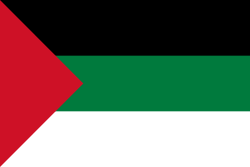 The flag of the Arab Revolt (1916)[29]
The flag of the Arab Revolt (1916)[29].svg.png) The flag of the Arab Islamic Republic (1974)
The flag of the Arab Islamic Republic (1974)
Contemporary flags
Islamic states
The modern conceptualization of the Islamic state is attributed to Abul A'la Maududi (1903–1979), a Pakistani Muslim theologian who founded the political party Jamaat-e-Islami and inspired other Islamic revolutionaries such as Ruhollah Khomeini. Six internationally recognized states identify as Islamic states: Saudi Arabia (formed 1932 out of the Wahhabist predecessor states), Pakistan (since 1947), Mauritania (since 1958), Iran (since 1979), Yemen (since 1991)The majority of countries of the Arab world define Islam as their state religion. Most of these states have national flags that include Islamic symbolism. Besides, there are unrecognized jihadist de facto states, such as the Islamic State of Iraq and the Levant controlling parts of Iraq and Syria, and the Taliban, Al-Shabaab and Boko Haram ruling parts of Afghanistan, Somalia and Nigeria, respectively, which use jihadist flags.
Some flags of Muslim states use inscribed flags, either with the shahada, as in the flags of Saudi Arabia, or in the case of the 1979 Islamic Republic of Iran, stylized writing of the word Allah. The flag of Iraq uses the pan-Arab colours since 1921, with the addition of the takbir since 1991. The practice of inscribing the shahada on flags may go back the 18th century, used by the Wahhabi religious movement.[30] In 1902 Ibn Saud, leader of the House of Saud and the future founder of the Kingdom of Saudi Arabia, added a sword to this flag.[30] The current flag of Saudi Arabia is a continuation of the flag Emirate of Nejd and Hasa introduced in 1902. The First East Turkestan Republic of 1933 used it on their flag, and the Taliban introduced it on their flag of Afghanistan in 1997.
 The flag of Saudi Arabia (1932, based on a 1921 variant), the shahada and a sword on a green field
The flag of Saudi Arabia (1932, based on a 1921 variant), the shahada and a sword on a green field The flag of Iran (1980), a highly stylized emblem representing the word Allah
The flag of Iran (1980), a highly stylized emblem representing the word Allah The flag of Afghanistan (2013, in variants since 1928) shows the national emblem, depicting a mosque with a mihrab with a prayer mat inside below the shahada
The flag of Afghanistan (2013, in variants since 1928) shows the national emblem, depicting a mosque with a mihrab with a prayer mat inside below the shahada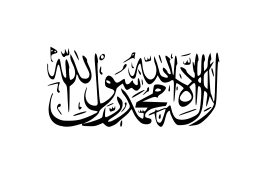 The flag of Afghanistan under the Taliban government (1996-2001)
The flag of Afghanistan under the Taliban government (1996-2001) The flag of Pakistan, a star-and-crescent on green which represent Islam[31]
The flag of Pakistan, a star-and-crescent on green which represent Islam[31]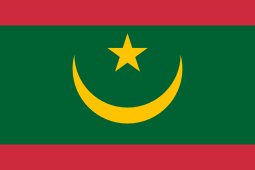 The flag of Mauritania (2017, variants since 1959), star-and-crescent on green
The flag of Mauritania (2017, variants since 1959), star-and-crescent on green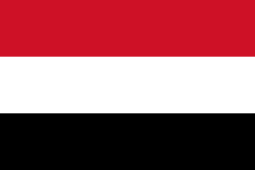 The flag of Yemen (1990), in spite of the constitutional definition of Yemen as an Islamic state implementing the sharia, does not include religious symbolism.
The flag of Yemen (1990), in spite of the constitutional definition of Yemen as an Islamic state implementing the sharia, does not include religious symbolism.
Denominational flags
.jpg)
Although a flag representing Islam as a whole does not exist, some Islamic denominational branches and Sufi brotherhoods employ flags to symbolize themselves. Among specific Islamic branches, Nizari branch of Ismaili-Shia Islam employs an official flag constitutes of green color which represents Muhammad's standard and Ali's cloak, as well as a red stripe meaning blood and fire. The flag was ordained by the Aga Khan IV as a part of the new constitution in 1986. The flag is flown on the Ismaili Jamatkhana, a place for congregational worship for Ismaili Muslims during the festive occasions.[32] The Ahmadiyya movement also employs an official flag (Liwaa-i Ahmadiyya) constitutes of black and white colors, first hoisted in 1939.[33] Mirza Tahir Ahmad, the fourth caliph of the Ahmadiyya Caliphate, explained the symbolism of the colours black and white in terms of the concept of revelation and prophethood.[34] Muslim African-American religious movement Nation of Islam deploys an official flag known as "The Flag of Islam" which symbolizes universal peace and harmony.[35]
In Shia Muslim traditions, flags are a significant part of the rituals for the Mourning of Muharram. Mourners take round the flags or banners in the ritual known as Alam Gardani as a performance for the mourning ceremonies. Mourners also use flags to signal the beginning and the end of the mourning. All flags have guardians and they are passed down through generations.[36]
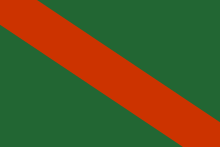
 The Ahmadiyya flag (1939)
The Ahmadiyya flag (1939) The Nation of Islam flag (1973)
The Nation of Islam flag (1973)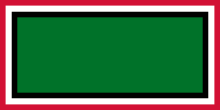 The Khatmiyya tariqa flag
The Khatmiyya tariqa flag
References
Footnotes
- Hathaway 2003, p. 95.
- Flag. Britannica. Retrieved February 15, 2019.
- Hinds 1996, p. 133.
- Nicolle 1993, p. 6.
- Hinds 1996, p. 108.
- Nour, “L’Histoire du croissant,” p. 66/295. See also Ibn Khaldun, Muqaddimah, pp. 214–15.
- Wellhausen 1996, p. 533.
- Hathaway 2003, p. 95-6.
- Muhammad b. Yazid b. Maja (d. 887), Sunan, ed. Muhammad Fu˘ad ˜Abd al-Baqi, 2 vols. (Cairo: Halabi, 1372/1952), vol. 2: 1366–67; ˜Ala al-Din ˜Ali b. Husam al-Din al-Muttaqi (1477–1567), Kanz al-˜ummål, 8 parts (Hyderabad: Da˘irat al-Ma˜arif, 1312/1894–95), part 3: 203; part 4: 38, 39, 45, 53
- Hathaway 2003, p. 96-7.
- Hathaway 2003, p. 98.
- Nozomi Karyasu & António Martins, 8 October 2006 on Flags of the World.
- The Muslim Empires of the Ottomans, Safavids, and Mughals, By Stephen F. Dale, 2009
- Hathaway 2003, p. 97-8.
- Hrbek 1997, pp. 34-43.
- e.g. Jaques Nicolas Bellin, Tableau des Pavillons de le nations que aborent à la mer (1756).
- Ottoman Empire: Flags and coats of arms shown in the Topkapi Museum (Istanbul)
- http://www.bl.uk/onlinegallery/onlineex/apac/addorimss/a/zoomify55414.html
- "Alam – The Flag of the Mughals". Mumbai: Khadi Dyers & Printers. Archived from the original on 21 November 2010. Retrieved 26 February 2010.
primarily moss green and some flags were scarlet. Against a green field it displayed a rising sun, partially eclipsed by a body of a couching lion facing the hoist
- Singh, K.V. (1991). Our National Flag (jpg)
|format=requires|url=(help). New Delhi: Publication Division, Ministry of Information & Broadcasting, Government of India. p. 14. - Blochmann, H. (tr.) (1927, reprint 1993). The Ain-I Akbari by Abu'l-Fazl Allami, Vol. I, Calcutta: The Asiatic Society, p.52
- Foster, William (ed.) (1921) Early Travels in India, 1583–1619, London: Oxford University Press, p. 306
- Terry, Edward (1777) [1655]. A Voyage to East-India. London: J. Wilkie. p. 347.
- "Flags of the World: Persia (Iran) from XVI to XVIIIth century". Retrieved 11 November 2010.
- "The Lion and Sun Motif of Iran: A brief Analysis". Retrieved 12 November 2010.
- "Encyclopædia Iranica: FLAGS i. Of Persia". Retrieved 12 November 2010.
- The symbolism of the star and crescent in the flag of the Kingdom of Libya (1951–1969) was explained in an English language booklet, The Libyan Flag & The National Anthem, issued by the Ministry of Information and Guidance of the Kingdom of Libya (year unknown, cited after Jos Poels at FOTW, 1997) as follows: "The crescent is symbolic of the beginning of the lunar month according to the Muslim calendar. It brings back to our minds the story of the Hijra (migration) of our Prophet Mohammed from his home in order to spread Islam and teach the principles of right and virtue. The Star represents our smiling hope, the beauty of aim and object and the light of our belief in God, in our country, its dignity and honour which illuminate our way and puts an end to darkness."
- Edward E. Curtis, Black Muslim religion in the Nation of Islam, 1960–1975 (2006), p. 157.
- Pan-Arab Colours, crwflags.com; Mahdi Abdul-Hadi, The Great Arab Revolt Archived 2014-05-05 at the Wayback Machine, passia.org
- Firefly Guide to Flags of the World. Firefly Books. 2003. p. 165. ISBN 978-1552978139. Retrieved 12 September 2012.
- "Pakistan flag". Ministry of Information and Broadcasting, Government of Pakistan. Archived from the original on 2007-10-26. Retrieved 2007-12-11.
- Ismaili flag & New Ismaili Constitution of 1986. Ismaili. Retrieved February 16, 2019.
- "A Brief History of Ahmadiyya Movement In Islam". Alislam.org. 1939-12-28. Retrieved 2016-03-23.
- "Question: Why do Muslims use black flags if the color black is associated with death and mourning?". Askislam.org. 1984-10-22. Retrieved 2016-03-23. "Black absorbs total light, [it] does not emit an iota of light, so from looking heavenly-wards black indicates that we absorb entire light from heaven, and white reflects total light without being dishonest about it, so a Messenger has two aspects. One of receiving things from Allah, in that respect he's nabi [prophet], whatever he receives he completely, totally absorbs, and when he speaks to the others he reflects the entire light without being dishonest or stingy about it, so that reflection makes it white. So reception that is a complete reception without leaving anything out and reflection that is a complete reflection without leaving anything out, they are witnessed only in two colours: black and white. So both have been employed in Islam as flags." "Archived copy". Archived from the original on 2015-06-30. Retrieved 2015-06-27.CS1 maint: archived copy as title (link)
- Brief history on origin of the Nation of Islam. Nation of Islam. Retrieved February 16, 2019.
- Muharram mourning traditions in different lands – 31. Parstoday. Retrieved February 16, 2019.
Bibliography
- Hathaway, Jane (2003). A Tale of Two Factions: Myth, Memory, and Identity in Ottoman Egypt and Yemen. State University of New York Press.CS1 maint: ref=harv (link)
- Hinds, Martin (1996). Studies in Early Islamic History. Darwin Press. ISBN 978-0-87850-109-0.CS1 maint: ref=harv (link)
- Hrbek, I. (1997). The disintegration of political unity in the Maghrib. In Joseph Ki-Zerbo & Djibril T Niane. General History of Africa, vol. IV: Africa from the Twelfth to the Sixteenth Century. UNESCO, James Curry Ltd., and Univ. Calif. Press.
- Sparavigna, A.C. (2016). The Sun, the Moon and the Mughal Emperors. SSRN Electronic Journal.
External links
| Wikimedia Commons has media related to Category:Islamic flags. |


